Key takeaways:
- Experiential learning fosters personal growth and enhances understanding of multicultural dynamics through hands-on involvement and reflection.
- Effective team dynamics, built on trust and the appreciation of diverse perspectives, are crucial for fostering creativity and problem-solving in multicultural settings.
- While multicultural teams bring benefits like enhanced creativity and adaptability, they also face challenges such as miscommunication and differing conflict resolution styles.
- Practical strategies for improving collaboration include setting clear expectations, encouraging active listening, and celebrating cultural differences to create an inclusive environment.
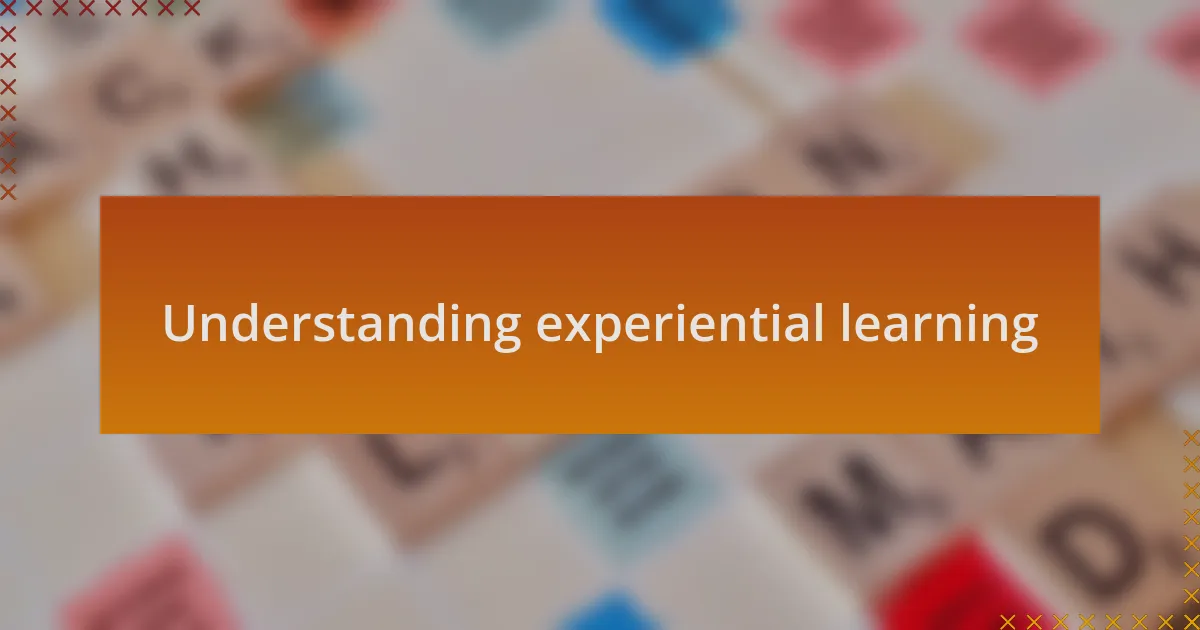
Understanding experiential learning
Experiential learning is all about learning through experience, rather than through traditional instruction. I remember the first time I participated in a team project that emphasized hands-on involvement; it was eye-opening. Instead of just listening to lectures on teamwork, I discovered how vital effective communication was when collaborating with diverse teammates.
Reflecting on my own journey, I often wonder how different my understanding of multicultural dynamics would have been if I hadn’t engaged in experiential learning. In one instance, I encountered cultural misunderstandings that initially seemed frustrating but turned into valuable lessons. These moments revealed the richness of diverse perspectives and taught me to approach challenges with an open mind.
This type of learning encourages us to reflect on our experiences and integrate those insights into our future interactions. When I faced a conflict in a team setting due to cultural differences, the debriefing process allowed me to unpack my feelings and reactions. It was a transformative experience, highlighting how experiential learning fosters both personal growth and deeper interpersonal connections.
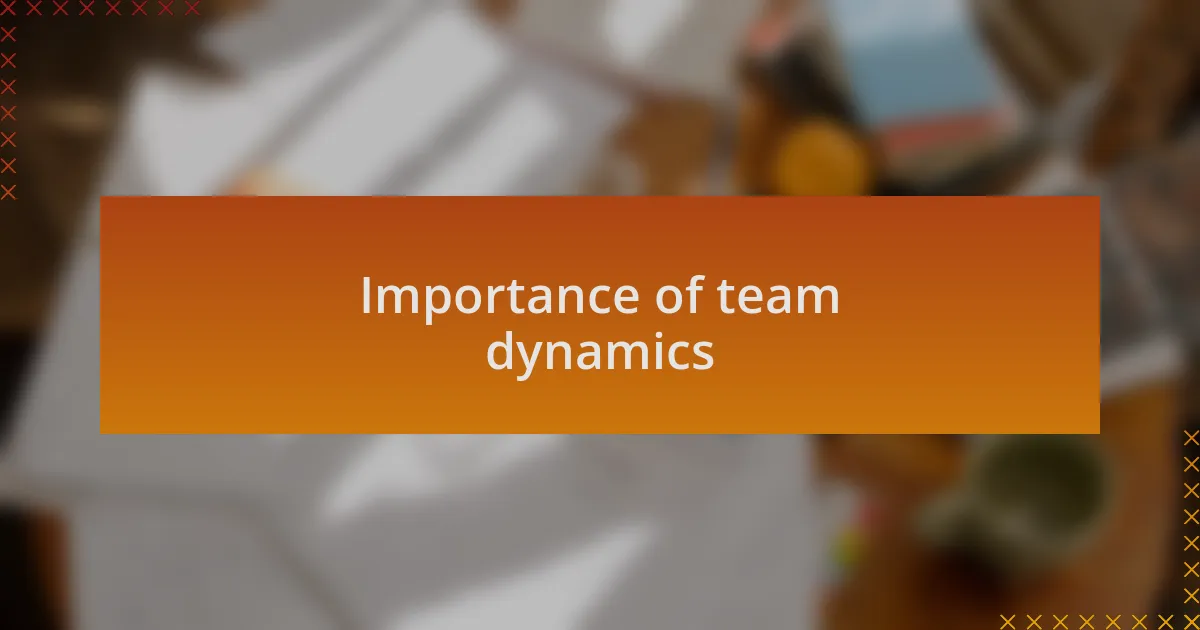
Importance of team dynamics
Effective team dynamics form the backbone of any successful collaboration. I recall a time when I worked with a group that had individuals from varied cultural backgrounds. At first, our different communication styles led to misunderstandings, but those very differences became our greatest strength, fostering creativity and innovative solutions.
One of the most significant lessons I learned was the importance of trust within the team. In a multicultural setting, I found that establishing trust involved being open about our individual perspectives. During one particularly challenging project, sharing personal experiences not only helped build rapport but also created a safe space where everyone felt comfortable contributing their unique ideas. Isn’t it amazing how vulnerability can lead to stronger connections?
Moreover, the value of diverse viewpoints became evident when we faced a tough decision. I remember proposing an idea that I thought was brilliant, only to receive feedback that shifted my perspective entirely. Instead of feeling defeated, I embraced the critique, realizing that our diverse opinions not only enhance problem-solving but also spark growth. Through these experiences, I came to appreciate that team dynamics are essential for fostering collaboration, creativity, and ultimately, success.
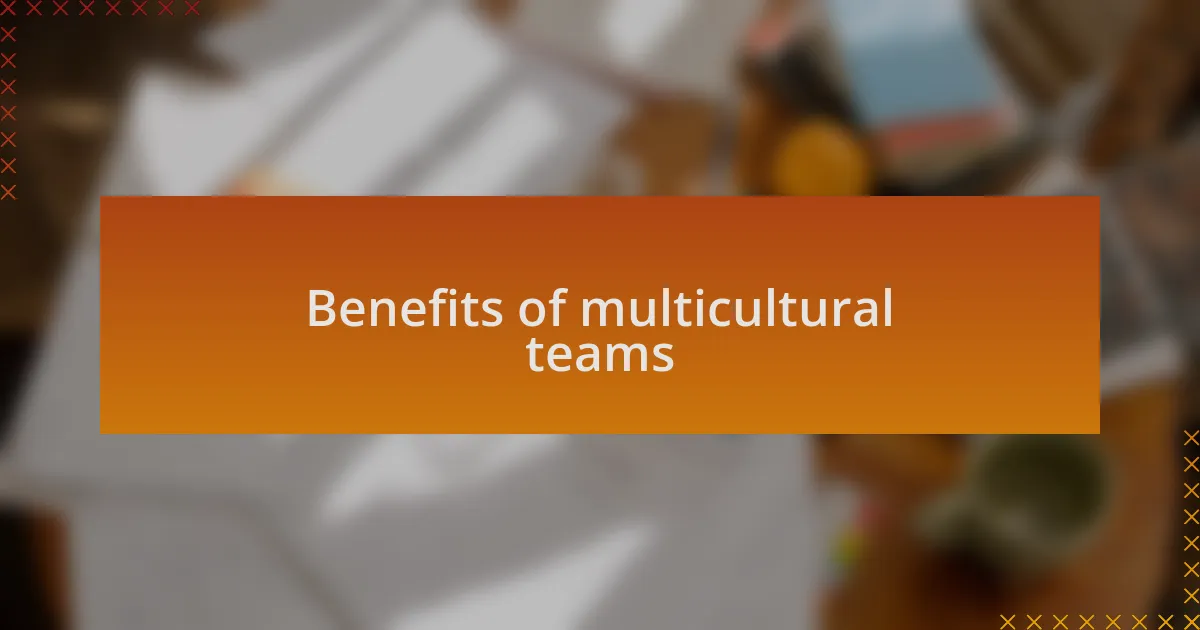
Benefits of multicultural teams
When I think about the benefits of multicultural teams, one remarkable advantage stands out: enhanced creativity. I once collaborated on a project where my team members hailed from five distinct countries. Each person brought a different cultural perspective to the table. I vividly recall a brainstorming session where someone suggested an idea that, at first, seemed far removed from our objectives. However, the discussion it sparked led us to a groundbreaking solution that none of us could have imagined alone. Isn’t it fascinating how diversity can open doors to innovation?
Another key benefit I’ve personally experienced is the increased adaptability within multicultural teams. During one instance, we faced an unexpected challenge that required us to pivot quickly. Each team member’s diverse background equipped us with various strategies and approaches for tackling problems. I found it enlightening to witness how different cultural experiences shaped our reactions and solutions. This adaptability not only kept us afloat but also taught me that flexibility in thinking is essential for thriving in today’s globalized world.
Additionally, working with a multicultural team has profoundly enriched my worldview. Engaging with colleagues from different cultures has encouraged me to examine my own biases and assumptions. I remember having a candid conversation with a teammate about cultural rituals that differ from my own. This discussion opened my eyes to the richness of our differences, which fosters empathy and understanding. Isn’t it wonderful how a simple exchange can lead to profound personal growth and a more inclusive mindset?
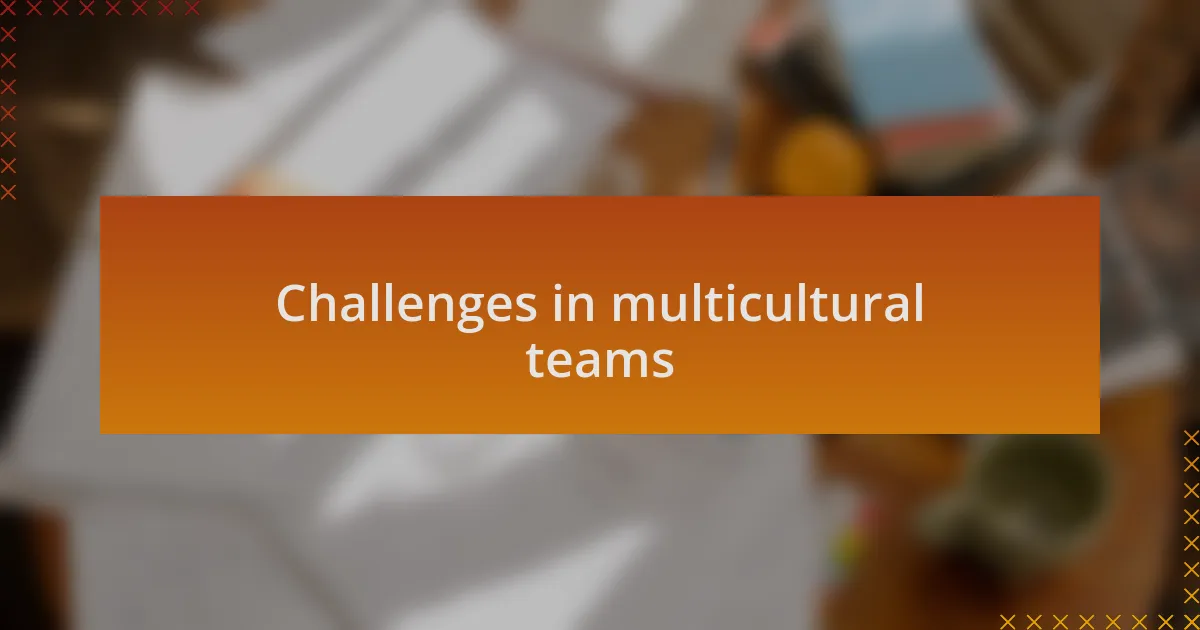
Challenges in multicultural teams
One of the most significant challenges I encountered in a multicultural team was the potential for miscommunication. During a project, a colleague mistakenly interpreted my feedback as critical when I’d intended it to be constructive. This misunderstanding created unnecessary tension and highlighted how language nuances and cultural expressions can vary vastly. Have you ever found yourself in a situation where something you said was taken the wrong way? It’s a reminder that we need to be mindful of our words and delivery.
Another hurdle I faced was differing approaches to conflict resolution. In one instance, I noticed that some team members preferred to address issues directly, while others opted for a more subtle approach that involved avoiding confrontation. This disparity led to a frustrating impasse when a disagreement arose. I learned that acknowledging these differences in styles became essential—rather than viewing them as obstacles, embracing them can help pave the way for a healthier dialogue.
Additionally, navigating diverse work ethics can be quite complex. I remember collaborating with a teammate who valued punctuality above all else, while my approach was more flexible. This clash sometimes led to misunderstandings around deadlines and accountability. Have you experienced similar situations? It taught me the importance of establishing clear expectations early on to align everyone’s efforts and cultivate a cohesive team dynamic.
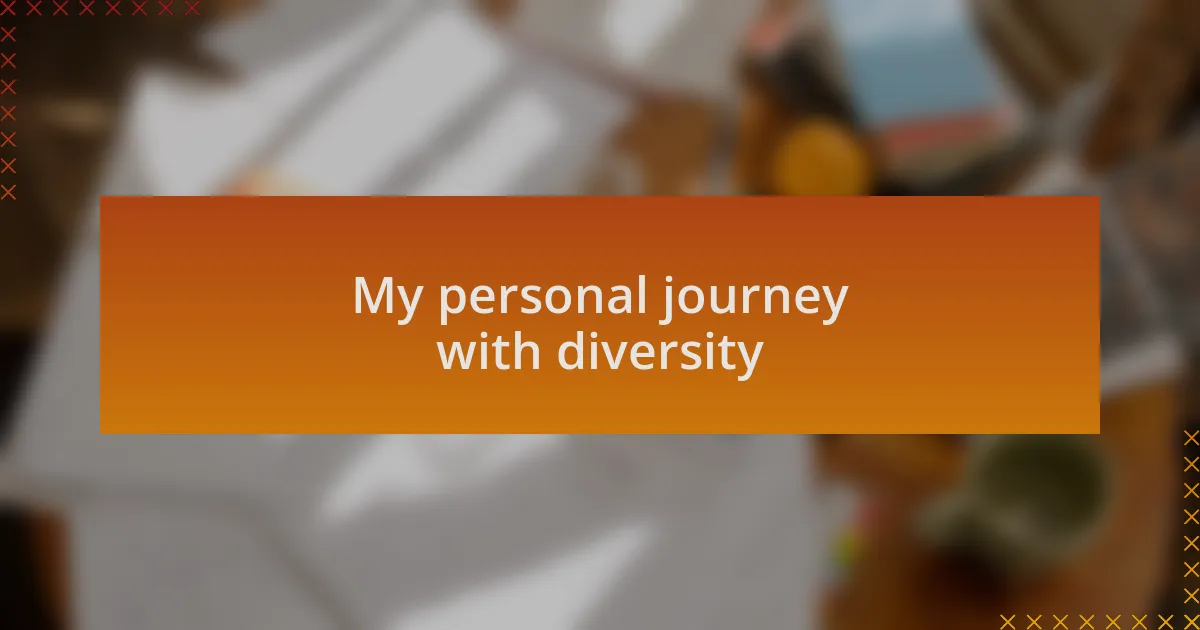
My personal journey with diversity
My journey with diversity began unexpectedly. When I first joined a multicultural team, I was excited yet nervous. I vividly remember a brainstorming session where our ideas collided in a beautiful mess. Each voice brought a different perspective, and it hit me that collaboration isn’t just about combining skills; it’s about blending cultures. Have you ever felt that spark when differences start to ignite creativity? For me, it was like discovering a treasure trove of experiences and insights.
As we progressed, I found myself increasingly drawn to my colleagues’ stories. I could feel the weight of their experiences shaping their viewpoints, and this deepened my appreciation for diversity. There was a moment during a lunch break when a teammate shared their family’s migration journey. I felt a mix of admiration and empathy, realizing how these individual backgrounds contributed to our teamwork. Moments like these made me question: How can my own background enhance our group’s outcomes? It inspired me to openly share my own story, recognizing that vulnerability fosters connection.
Over time, I embraced the richness that diversity added to our team’s fabric. I recall a project where we decided to draw from our respective cultural traditions to present our findings uniquely. Not only did this creatively highlight our differences, but it also unified us under a common purpose. It led me to understand that diversity is not merely an element to manage; it’s a powerful source of innovation and resilience. Reflecting on these experiences, I can’t help but wonder: What might we achieve if we fully embraced our differences instead of viewing them as mere challenges?
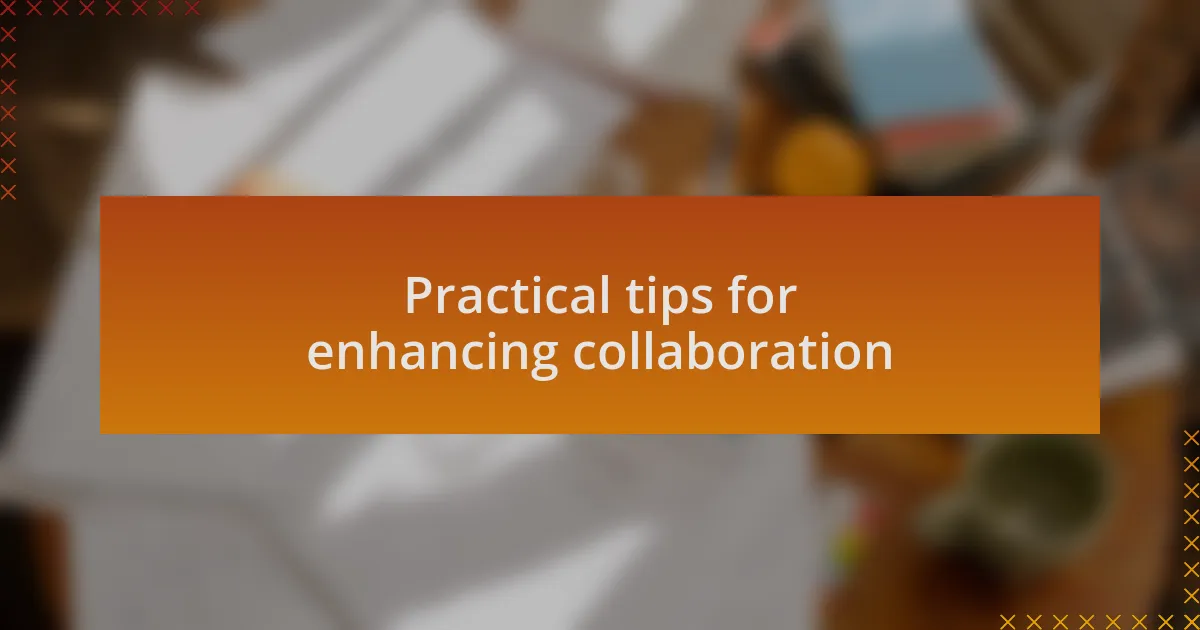
Practical tips for enhancing collaboration
When it comes to enhancing collaboration in a multicultural team, setting clear expectations can make a significant difference. I remember leading a project where we agreed on communication norms, like responding within a specific timeframe to emails. This small step fostered accountability and respect for each other’s time zones and work styles. Have you ever noticed how clarity can eliminate confusion?
Another practice that proved invaluable was encouraging active listening during discussions. In one meeting, a teammate from a different cultural background expressed their ideas hesitantly. By consciously asking them to elaborate, I saw their confidence grow, and suddenly our conversation flourished. Isn’t it fascinating how giving someone the floor can transform the dynamics of engagement? It taught me that listening is just as important as contributing.
Finally, celebrating cultural differences can create a more inclusive atmosphere. I initiated “Cultural Exchange Days” where each team member presented something unique about their background. I still smile thinking about the laughter and creativity that erupted when we tasted each other’s traditional dishes. Could there be a better way to strengthen bonds than sharing food and stories? This shared experience not only sparked joy but bonded us on a personal level, reinforcing the strength of diversity in our collaboration.